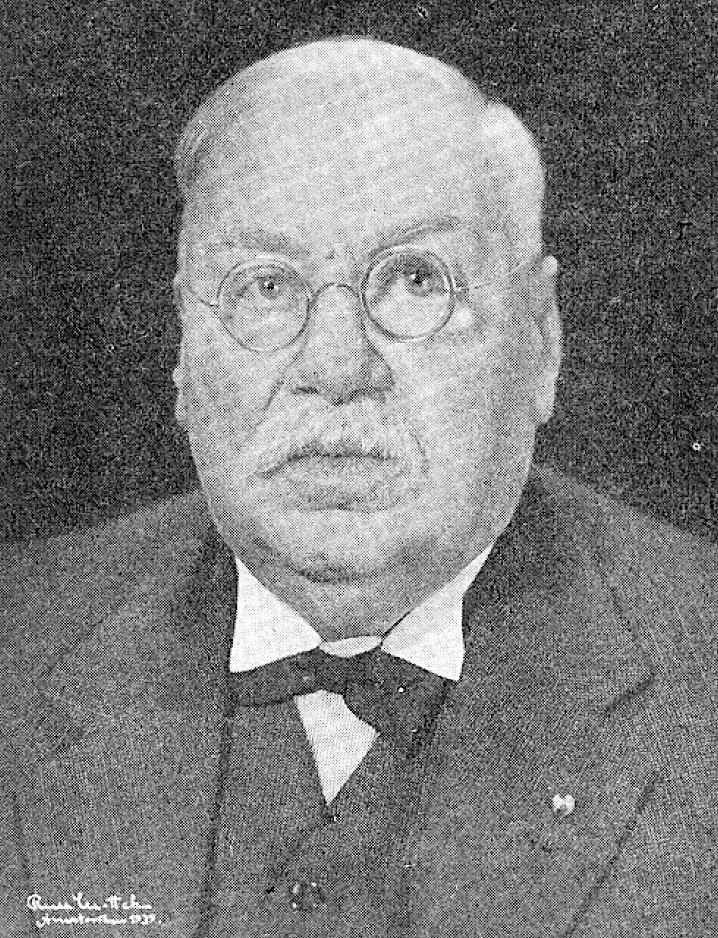The summit meeting East ⇔ West
The history of the brewery highlights two great technical and social traditions. They have coexisted and ignored each other for several millennia, even if here and there some travellers and great merchants such as Marco Polo and many others reported the existence of fermented drinks based on rice, millet, barley or wheat in China, Japan and all Asian countries. These two brewing traditions really came into contact at the end of the 19th century, when scientists and engineers, both European and Asian (especially Japanese), studied brewing techniques from across the world.
Not surprisingly, they recognised that these technological traditions were based on the same biochemical principles, the same fundamental mechanisms for converting starch into sugars, and fermentable sugars into ethanol. In short, brewers all over the world, in Asia as in Europe and America, were making true beers, even if the traditional or industrial processes varied.
The brewing Asian tradition has favoured the path of complex and collaborative fermentations through several complementary techniques:
- The conversion of starch is triggered by a culture of specific microorganisms. It is exogenous in relation to the material to be hydrolysed: rice, millet, wheat, etc. starch. That is to say, it works thanks to the addition of specific ingredients rich in enzymes capable of hydrolysing the starch (the amylolytic ferment also called beer starter).
- Alcoholic fermentation is carried out by yeasts (sometimes by a few species of amylolytic fungi wich have a metabolic pathway to convert glucose into ethanol) but in a non-liquid wet environment. The amylolytic starter also provides the necessary additional yeasts in traditional methods.
- The starch conversion and the alcoholic fermentation take place simultaneously in the same container. The balance of the two biochemical reactions is regulated by the temperature, the acidity of the medium and the proportion of free water (water activity).
- This technology produces relatively alcoholic (& gt; 12% -15% v. Alcohol), non-sparkling (non-liquid medium) beers and therefore foam-free.
The western tradition has split into two phases the fundamental biochemical conversions, the starch hydrolysis and the alcoholic fermentation:
- The conversion of starch through grain germination (malting) is endogenous to the starch source in that it activates the enzymes produced by cereal grains themselves as they germinate.The resulting sweet wort is filtered and boiled, which stops all activity of the saccharifying enzymes (amylases) from the malt once and for all.
- The alcoholic fermentation is carried out by yeasts added in a liquid medium (the must). The activity of the water is close to 1, which favours the activity of the yeasts.
- The starch conversion and the alcoholic fermentation take place in two successive and completely separate stages.
- This technology produces beers with a lower alcohol content (5 - 10% alcohol v.), sparkling if the CO2 is retained, and therefore frothy. Highly alcoholic western beers are obtained by concentrating the alcohol and freezing the beer. The different densities of water and alcohol make it possible to separate them. This process takes place after the actual alcoholic fermentation.
The appearance of the traditional Asian beers has led most authors on the false trail of wines. This mistake has been reinforced by Chinese social history. The refined and socially differentiated drinking styles surrounding the consumption of these beers, an image of a traditional hierarchical society, have inspired comparisons with the western bachic culture rather than with its beer taverns. Historians, poets and novelists cannot imagine comparing the legendary and exquisite rice or millet beverages of the imperial court with the "coarse" beer of medieval populaces, or the divine sake with the fermented porridge of an African village! However, beyond the historical borders of China or Japan, this brewing technique drives the production of traditional rice, millet or barley beers throughout Asia, among societies with little hierarchy. Specialists call these fermented beverages "beers" without reservation. This incoherence should have been a wake-up call to historians and specialists in Chinese and Japanese culture.
Conversely, the Western industrial brewers wanted to mark the difference between their products and traditional Asian beers. The reasons are to be found in the colonial policies of the end of the 19th century. Western brewers were only accountable (in the fiscal sense of the taxes paid) to the economic and political power of their respective metropolises, not to the treasury of the colonised countries which retained the taxation of their traditional brewing. Confusing or assimilating local beers with foreign beers was unthinkable. This commercial logic lasted in the 20thcentury until the governments of these countries became independent and took over the Western breweries installed in Asian countries. The most beautiful example is the Chinese brewery Tsingtao, today known worldwide, originally a German colonial brewery installed in 1903 in Qingdao (Shandong province) on the Yellow Sea to supply its naval base.
However, there have been attempts on both sides to merge these two great brewing traditions, or at least to enrich them by borrowing and adapting their respective technical processes. These initiatives, which have remained without success, were the brainchild of engineers and researchers.
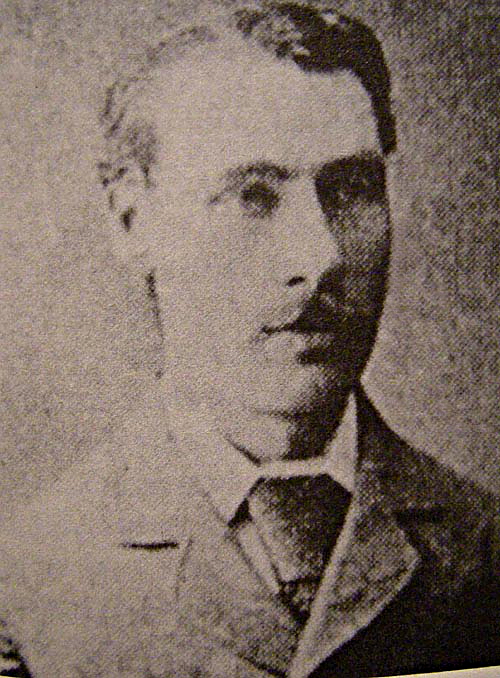 1st example : In 1878, Robert William Atkinson (1850-1929), a British professor of chemistry at the University of Tokyo, described in detail to the learned societies of London the techniques of brewing sake, the Japanese rice beer (Journal of the Society of Arts, September 20th 1878, 908-909). New session within the framework of the Cantor Lecture (physics-chemistry section) on April 14th 1883 about the activity of the diastasis of kôji (ferment of the sake). It completes and rectifies the important study by Professor Atkinson published in 1881, The Chemistry of Sake Brewing, Memoirs n° 6 of the Science Department, Tôkiô Daigaku. In his preface, Atkinson points out that the only scientific documents on the sake are in 1881 a translation from Japanese published in Leiden in 1714, a German study by Dr. Hoffman, professor at the medical school of the University of Tokyo (Transactions of German Asiatic Society of Japan), and another by O. Korschelt. For all these scholars, there is no doubt that the sake is a beer that they liken to European beers. The aim of their research is to describe their brewing techniques in order to confront them with Western processes. Atkinson's introduction leaves no doubt about the parallel he draws between the malting of cereals (the Western brewing method) and the work of the kôji (ferment of the Japanese brewing method):
1st example : In 1878, Robert William Atkinson (1850-1929), a British professor of chemistry at the University of Tokyo, described in detail to the learned societies of London the techniques of brewing sake, the Japanese rice beer (Journal of the Society of Arts, September 20th 1878, 908-909). New session within the framework of the Cantor Lecture (physics-chemistry section) on April 14th 1883 about the activity of the diastasis of kôji (ferment of the sake). It completes and rectifies the important study by Professor Atkinson published in 1881, The Chemistry of Sake Brewing, Memoirs n° 6 of the Science Department, Tôkiô Daigaku. In his preface, Atkinson points out that the only scientific documents on the sake are in 1881 a translation from Japanese published in Leiden in 1714, a German study by Dr. Hoffman, professor at the medical school of the University of Tokyo (Transactions of German Asiatic Society of Japan), and another by O. Korschelt. For all these scholars, there is no doubt that the sake is a beer that they liken to European beers. The aim of their research is to describe their brewing techniques in order to confront them with Western processes. Atkinson's introduction leaves no doubt about the parallel he draws between the malting of cereals (the Western brewing method) and the work of the kôji (ferment of the Japanese brewing method):
« The study of the chemical reactions involved in the brewing process described in the following pages has brought to light a fact of some importance relating to the physiology of plants, vis. that the growth of a mold over the surface of perfectly dead rice grains causes a change in the character of the albumenoid matter of the grain resembling that which results from the germination of the embryo of similar grains. » (Atkinson 1881, 5)
On the necessary cooperation between Western and Asian researchers, Atkinson is equally explicit:
« I cannot omit here to draw attention to the mutual advantage to be derived from an association of workers in industrial and in pure science; the cooperation cannot but be of the greatest utility on the one hand, by suggesting new subjects for research to the theoretical worker, and on the other, in aiding the practical man to attain the best results possible. The student of science in Japan has a wide field before him; that system of isolation which has prevented the introduction of Western knowledge till within the last quarter of a century has not been entirely fruitless, for it has resulted in the development of industrial processes which are as novel and interesting to the European as those of the latter are to Japanese. The scientific students of the university and colleges of Japan need not, therefore, look very far in order to find subjects that require investigation and explanation, and this search will, without doubt, add largely to the sum total of existing knowledge. » (Atkinson 1881, 5)
Atkinson's wishes will be fulfilled in the scientific field. The chemists will identify the enzymes[1], gradually understanding their mechanisms. But the impact of his research on brewing techniques in Europe or the United States will remain close to zero!
The French scientists are not going to be any more successful in this respect.
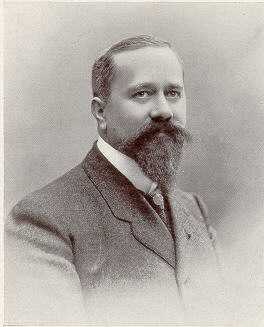 2nd example : Albert Calmette, a student and then assitant of Louis Pasteur, founded in 1891 the first overseas institute in Saigon, capital of the French colonial Indochina. Calmette, who was also a great doctor who, together with Camille Guérin, invented the tuberculosis vaccine, studied local fermented beverages, particularly rice beers (baptised "vin moï"). He describes this ancestral process which he calls amylo-process, i.e. the saccharification of starch coupled with an alcoholic fermentation obtained by making a ferment, known at that time under the colonial name "Chinese yeast". He obtained his approximate recipe from the female brewers of Saigon and reconstituted his formula with 46 more or less aromatic vegetable ingredients. Some are carriers of Mucor, a mushroom with a very strong diastasic power. In 1892 Calmette studied its characteristics with the aim of producing cheap alcohol for brewers with concentrated starch sources (potato, manioc) without going through the costly malting process[2]. Voidin perfected the process with strains of Amylomyces rouxii (named in Dr Roux's homage). He will move on to the industrial stage for other uses and needs (alcohols and industrial solvents) than those of western or Asian breweries. Amylo-process was first used in Seclin near Lille and in Antwerp, before it was adopted everywhere.
2nd example : Albert Calmette, a student and then assitant of Louis Pasteur, founded in 1891 the first overseas institute in Saigon, capital of the French colonial Indochina. Calmette, who was also a great doctor who, together with Camille Guérin, invented the tuberculosis vaccine, studied local fermented beverages, particularly rice beers (baptised "vin moï"). He describes this ancestral process which he calls amylo-process, i.e. the saccharification of starch coupled with an alcoholic fermentation obtained by making a ferment, known at that time under the colonial name "Chinese yeast". He obtained his approximate recipe from the female brewers of Saigon and reconstituted his formula with 46 more or less aromatic vegetable ingredients. Some are carriers of Mucor, a mushroom with a very strong diastasic power. In 1892 Calmette studied its characteristics with the aim of producing cheap alcohol for brewers with concentrated starch sources (potato, manioc) without going through the costly malting process[2]. Voidin perfected the process with strains of Amylomyces rouxii (named in Dr Roux's homage). He will move on to the industrial stage for other uses and needs (alcohols and industrial solvents) than those of western or Asian breweries. Amylo-process was first used in Seclin near Lille and in Antwerp, before it was adopted everywhere.
3rd example : In Japan, Jokichi Takamine obtained a degree in chemical engineering from the University of Tokyo in 1879. He was selected to complete his training in Scotland, at the University of Glasgow and Anderson College. The Japanese government of the Meiji era pursued a policy of accelerated assimilation of Western knowledge. Returning to Japan in 1883, Takamine joined the Ministry of Agriculture and Trade and headed the chemical division. A year later, he made his first trip to the United States. In 1887, Takamine set up his own fertilizer factory for agriculture. In his laboratory, he developed the takadiastase, an enzymatic preparation derived from Aspergillus oryzae, the favourite fungus of the sake brewers. He is marketing his patented discovery in the United States, the Takamine. In 1901, he was the first to isolate and purify a glandular hormone: adrenaline. Takamine develops industrial and scientific relations between Japan and the United States.
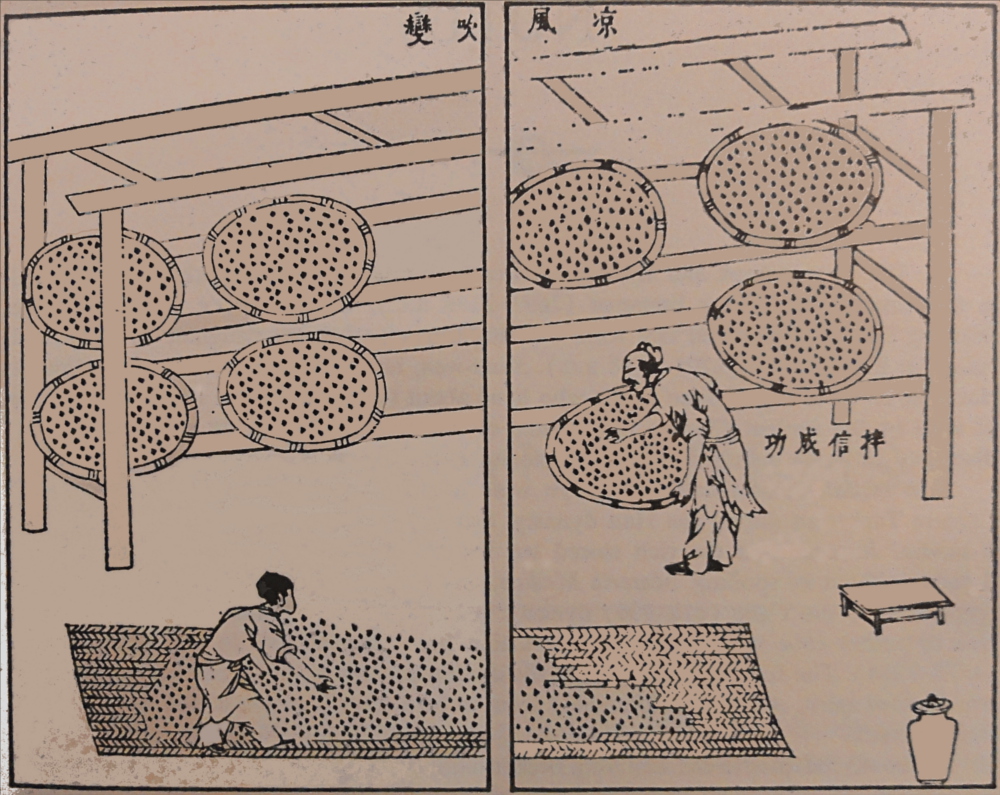 hong zhao beer from red rice saccharified and fermented with Monascus.
hong zhao beer from red rice saccharified and fermented with Monascus.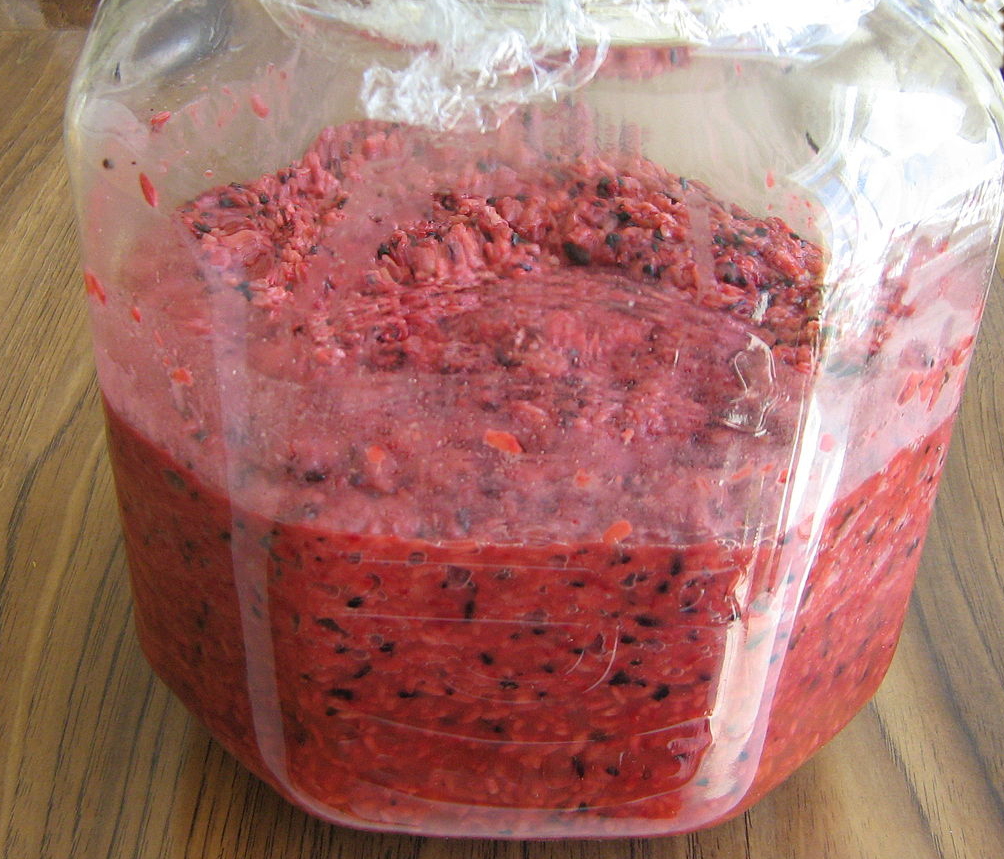
4th example : The Dutch will study in the East Indies (Java) the ragi, the Javanese equivalent of the Vietnamese ferment[3]. The colonisation of Java by the Dutch brought botanists into the field seeking to identify and describe new plant species. Mushrooms are among them. In 1884, the French botanist Philippe van Tieghem described the genus Monascus, a filamentous fungus. In 1895, Went isolated the Monascus purpureus from samples collected by Dutch scientists in Java (Went 1895). This mushroom has two remarkable properties. It secretes enzymes that convert starch into fermentable sugars, and it reddens the substrate on which it is grown, usually rice. The people of Java have used this fungus for centuries to brew their rice beer, the ragi , and to colour their glutinous rice porridges.
It is because of the red pigment colouring the rice that Dutch scientists have spotted and observed Monascus in Java. Historical research has shown that the use of Monascus was much wider and older, ranging from Korea to Java via Japan, China and Vietnam. Cultivated on cooked rice balls or patties, it is used as an amylolytic ferment for brewing various types of rice or millet beer. These dried ferments also have a secondary medical use. In Europe, Monascus is described by botanists of the French and Dutch learned societies, but has no industrial application, apart from the production of natural red food colouring. The main property of the amylolytic ferment, its amylases, remains neglected.
In 1898, Prinsen-Geerligs submitted a treatise to the Academy of Sciences in Amsterdam on "the yeast species and sugar fungi of the arak factory". The saccharifying action of the " sugaring fungi " (Rhizopus) is described as a preparatory stage of the alcoholic fermentation. But just as with Calmette's "Chinese yeast", its application will be limited to the distillation of alcohols for industry or cheap spirits for human consumers. No one would imagine that brewing methods based on the germination of cereals would evolve in Europe (or elsewhere).
Here again, nothing is moving on the brewers' side on either side of the Pacific. The biotechnologies are innovating. The understanding of enzymatic mechanisms is progressing. Applications are multiplying in the agro-food sector. However, curiously, the view of Asian fermented beverages is not changing. Japanese sake, Chinese jiu, Korean takju, etc. are still considered as traditional "wines", unrelated to western industrial beer. The hindrance is cultural, but obviously above all economic [4]. In 2021, the situation is unchanged. Western and Asian researchers and authors still translate jiu or sake as "rice wine" instead of "rice beer", while laboriously explaining that these beverages are actually beers brewed in breweries by sake or jiu brewers!
No brewer on either side of the Pacific takes the risk of introducing under the name "beer" a fermented beverage whose appearance, taste and alcohol content differs so much from what each continent calls sake in the East and lager in the West. Which western tax and customs administration would take the risk of allowing rice or millet beers with labels bearing this explicit designation to be imported into its territory? The beer industry's reaction will certainly one of a general outcry.
Will the globalised landscape of the 21thcentury make this situation evolve?
The crossbreeding of Asian and European brewing processes would probably not produce new interesting types of beer. On the other hand, the creation of new brewing methods based on the fundamental Asian and Western brewing processes would be promising.
[1] Eduard Büchner published in 1897 "Alkoholische Gährung ohne Hefezellen" (Alcoholic Fermentation without yeast cells) in which he shows that this fermentation, carried out with finely crushed yeasts, hence destroyed cells, is working through chemicals mechanisms only, not thanks to a mysterious vital principle
[2] Calmette A. 1892, Contribution à l'étude des ferments de l'amidon. La levure chinoise. Annales de l'Institut Pasteur 6, 604-620. CONTRIBUTION A L'ÉTUDE DES FERMENTS DE L'AMIDON. LA. LEVURE CHINOISE. This most interesting text explains the situation in detail: the Chinese monopoly on the manufacture of rice beers with amylolytic ferments in return for a fixed annual fee paid to the French colonial government (2,400,000 francs), the financial interest of this same government which wants to circumvent this monopoly that expired in January 1894 and encourages Calmette's research to discover the secret of the " Chinese yeast ". And finally the success of Calmette who manages to cultivate a very efficient beer ferment in the laboratories of the Pasteur Institute of Saigon. The colonial government was able to make and sell rice beer from 1894 onwards, without Chinese middlemen. Calmette exploited this invention in France to produce cheap distilled alcohol for industrialists. See also Annick Guénel , The Creation of the First Overseas Pasteur Institute or the Beginning of Albert- Calmette's Pastorian Career, Medical History, 1999, 43: 1-25. Especially pp. 18-20 => researchgate.net/publication/12434246
[3] Wanping Chen, Yi He, Youxiang Zhou, Yanchun Shao, Yanli Feng, Mu Li, and Fusheng Chenn (2015), Edible Filamentous Fungi from the Species Monascus: Early Traditional Fermentations, Modern Molecular Biology, and Future Genomics, in Comprehensive Reviews in Food Science and Food Safety Vol.14, 2015. doi: 10.1111/1541-4337.12145.
Went and Prinsen-Geerligs 1896, Beobachtungen über die Hefearten und zuckerbildenden den Pilz des Arackfabrikation. Verth. Kon. Ned. Akad. Wetensch., Afd. Natuurh., Tweede Sect. II 4, 3-31.
Van Tieghem M. 1884. Monascus, genre nouveau de l’ordre des Ascomycetes. Bull Soc Bot Fr 31:226–31.
Went FAFC. 1895. Monascus purpureus, le champignon de l’Ang-quac. Une nouvelle thélébolée. Ann Sci Nat Bot 81:1–18.
[4] Forthcoming articles by Beer-Studies will show how the European colonial powers (British, German, French, Dutch) have established in Asia "breweries in the Western way" during the 19th and 20th centuries, considering the local beers as indigenous beverages unfit to be drank by European people. And how Asian countries, newly politically independent, have perpetuated this dichotomy and even increased it after the Second World war in the Pacific. Japan and its powerful brewing industry offer an exemplary case. The financial capital of the great Japanese food Companies controls the lager breweries as well as the sake breweries, but their businesses are completely separate, in order to fit specifically to the Asian and Western markets.




